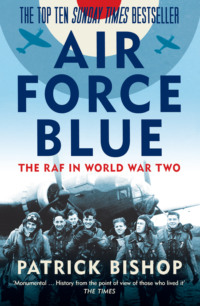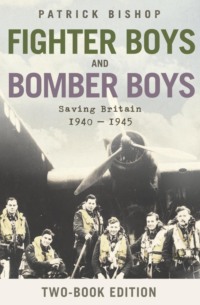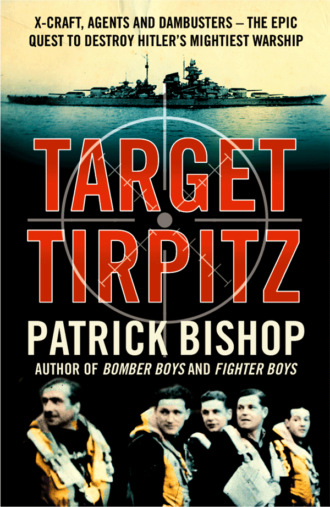
Полная версия
Target Tirpitz: X-Craft, Agents and Dambusters - The Epic Quest to Destroy Hitler’s Mightiest Warship
They started yelling again, ‘shouting “hurry up, the water is rising”’. Their room was still dry but they could see the compartment below them filling up. Zuba felt they were ‘in a running race with death’. The torch noises were getting closer, though. Someone ‘puts his hand on the steel wall. It is quite warm. “Hurry!” we shout.’
Then, a molten red spot appeared on the wall, followed by a shower of sparks. They shouted with joy ‘like little boys’, as the glowing line crept along the wall. They were ‘staring at it, drinking in every centimetre of its growth’, when ‘suddenly the hissing stopped. We heard voices moving away. There was a deathly silence around us.’
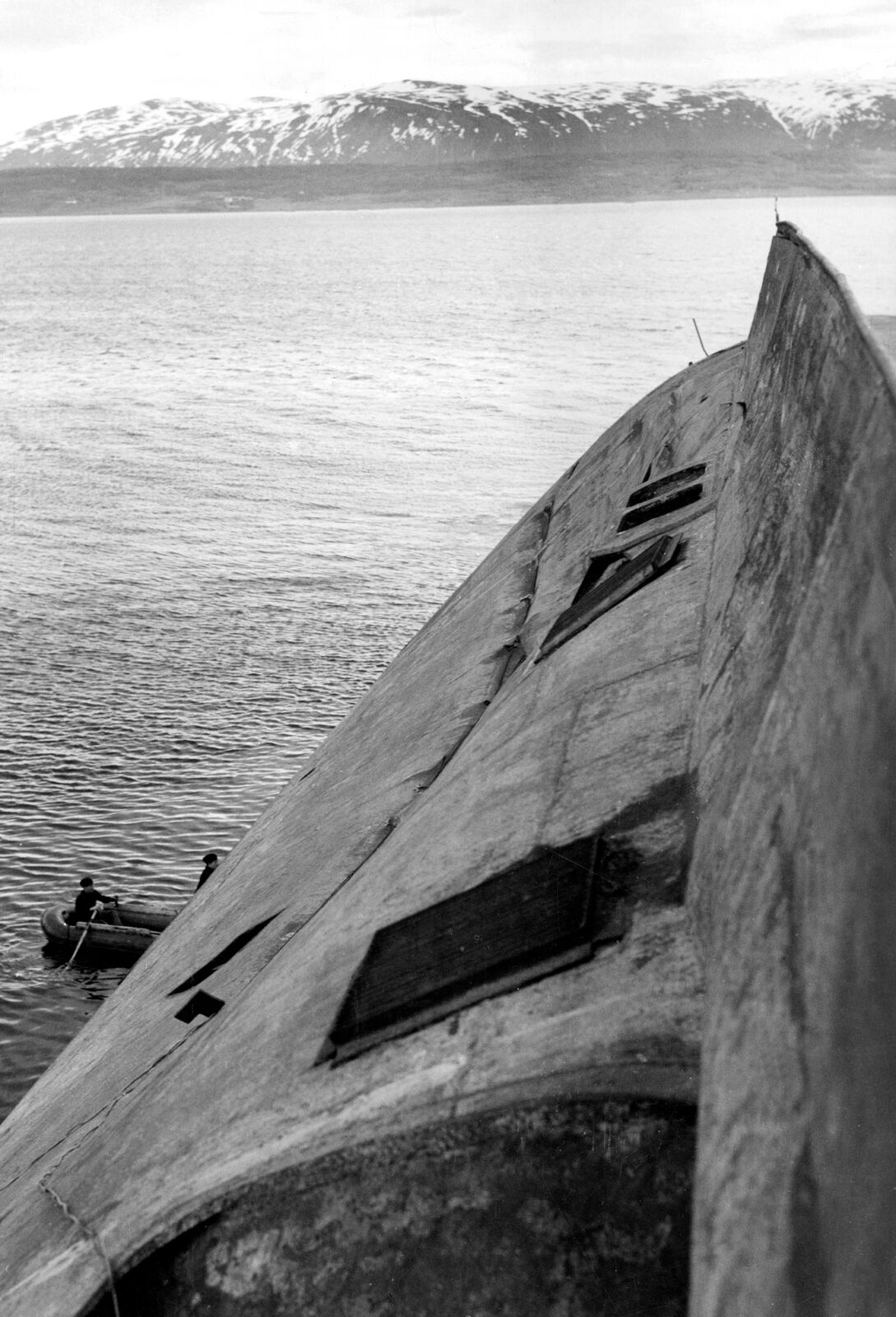
The last berth
The captives shouted in dismay. They screamed and banged on the cold steel walls of their prison, but ‘there is no answer, only the echo of our desperate shouting’. In the darkness below they could make out a ‘mirror of black gleaming water’ rising towards them.
Just as despair settled over him, Zuba heard more banging and sparks sprayed from the wall. A molten spot reappeared and slowly traced a glowing rectangle. There was a clang of falling metal and faces appeared in the hole. Their saviours looked ‘as if they had come from another world’. The hole was only sixteen inches wide. Each man had to be pushed and pulled through it. They emerged into another space with a ladder leading upwards. When Zuba reached the top he saw a square in the metal above him and, through it, the sky. It was evening. The stars ‘were twinkling, a sight I will never forget.’ He climbed up, and out into freezing night, ‘standing free and saved and sucking … air into my lungs’.
He was standing on a vast expanse of red-leaded metal. It took him a moment to realize it was the hull of the ship. As he was led away a soldier told him why the rescue had been broken off. Working in the cramped space between the hull and the lower deck, the welders had started to pass out from lack of oxygen. The twenty survivors were put on a launch and taken off to another ship, where they were fed and bathed and clothed. Zuba was anxious to know the fate of the men he was with when the ship began to topple. Leutnant Mettegang was still missing, believed trapped with twenty-four men. Next day, when Zuba asked again for news, he was told they were dead. According to the story that went around, the rescue team had been able to hear the trapped men but not to reach them. They had been singing ‘Deutschland, Deutschland, Über Alles’ before they suffocated.1
* See Ranks of the Kriegsmarine, p. xix, for equivalent British rank.
Chapter 2 Wilhelmshaven, Saturday, 1 April 1939
Adolf Hitler descended from a Mercedes limousine and strode along the dockside beneath the slipway supporting the gigantic hull. His face wore an expression of childish delight as he looked up at the soaring flank of his new battleship, then turned to salute the crowds packed in thousands in orderly squares alongside. They had been brought in from all over Germany’s ever-expanding territories to provide the numbers needed for a theatrical display of might and played their part enthusiastically, cheering, waving swastika pennants, pressing forward for a glimpse of the leader as he strode past.
He skipped up the steps to a high platform raised before the bow. It was a bright, sunny day but a cold wind whipping in from Jade Bay snapped at the flags and bunting and rattled the still-bare branches of the trees. Surrounding him on the platform was a cluster of admirals and generals. Among them, wearing a cloche hat and a fur stole, stood a lone woman. Frau Ilse von Hassell was there to name the ship in honour of her father, Admiral Alfred von Tirpitz, the architect of the Imperial German navy. She was a reluctant participant. Her husband Ulrich, a diplomat, had watched the ascent of the Nazis with dismay. The head of the modern German fleet, Admiral Erich Räder, had first asked Tirpitz’s seventy-eight-year-old widow Marie to perform the ceremony but she claimed to be too old and infirm to attend. He turned next to Ilse and her younger sister Margot but they too declined. Ilse recalled that he then ‘sent a second appeal, urgently demanding my presence. It was practically an order. I need not explain … what such an order meant in those times in Germany.’1
The Führer and the admiral’s daughter stood in the blustery wind for a minute or so in uncomfortable silence. Eventually he looked down at the sea of joyful, upturned faces and, ‘in a sort of monotone’, murmured: ‘I have sent trains to all parts of Germany, of Austria, of Czechoslovakia. It is the best propaganda.’ An official called her forward to the microphone. In a clear voice she declared: ‘By order of the Führer and Supreme Commander of the Wehrmacht, I christen you with the name “Tirpitz”.’ The bottle swung and smashed. A large, hand-lettered sign reading TIRPITZ in Gothic script was lowered over the side. Then the hull began to move slowly, gathering speed as it went, stern-first down Slipway No. 2 hitting the basin in a maelstrom of churning water. Only the steel vanes welded onto the sides, sticking out like elephant’s ears, prevented a collision with the far jetty. The cheers of the crowd mingled with ‘Deutschland Über Alles’ blaring from loudspeakers as the notables descended the steps and were driven to the town hall square for the next event.
The day was charged with nervous expectation. The world was watching Wilhelmshaven. Europe was sliding towards war and Hitler’s words might give a sign of how fast or slow the catastrophe would be in coming. The omens were not good. The previous day Britain had abandoned its policy of appeasement. The decision had been forced by Hitler’s demand that Poland hand over the free city of Danzig, prised from Germany by the Treaty of Versailles. The Prime Minister, Neville Chamberlain, who stood by timidly as the Reich swallowed Austria and Czechoslovakia, had at last made a stand, telling the House of Commons that Britain and France would lend Poland ‘all the support in their power’ if Germany attacked.
The volte-face triggered a Wagnerian rage. Hitler had hoped he would not have to go to war against the British. Admiral Canaris, the head of German Military Intelligence who was with him when the news came through, watched as he pounded his fists on a marble table, his face contorted with anger, shouting that he would ‘cook them a stew they’ll choke on’.2 At around noon, Hitler began the speech everyone was waiting for. Wilhelmshaven’s main square had been decked out Nuremberg-style with flags and banners. Reporters in the press area noticed something they had not seen before at such events. Hitler was standing behind a curved glass screen, apparently designed to protect him from an assassin’s bullet.
His speech was long and disjointed, now soft, now hard, swinging between cajolery and bluster. Its main theme, though, was Britain, or ‘England’ as Germans chose to call it. The change of heart in London amounted to a declaration of enmity. Instead of staying on the sidelines as Hitler had hoped, Britain, its army and above all its navy would now have to be counted in the forces arrayed against his plans for European domination.
He started by reopening an old wound. He reminded the crowd that during the last war the British had ‘systematically’ encircled Germany, imposing a ‘hunger blockade’ that had resulted in hundreds of thousands of deaths. Now, by blocking her efforts to reclaim her historic territories, she was seeking to do so again. Germany, he warned, was ‘not going to put up in the long run with a policy of intimidation or … of encirclement’.
The warning was reinforced by a threat aimed at the British navy – which had enforced the wartime blockade. Only four years before, Britain and Germany had agreed a naval pact that limited the size of the German fleet. It had been based, he said, ‘on the fervent desire we all possess never to go to war with England’. He went on: ‘If this wish no longer exists in England, then the practical condition for this agreement is removed.’ The German people would be ‘quite content to put up with this. We are so sure of ourselves because we are so strong and we are strong because we are united.’3
The speech ended in a volley of ‘sieg heils’. Hitler was driven away to board a launch which sped out into the sparkling waters of Jade Bay, carrying him to the battle cruiser Scharnhorst, which had gone into service less than three months before and seemed to embody all the power and vigour of the new order. There he was met by Erich Räder, carrying the baton which marked his promotion that day to the rank of Grossadmiral – the highest pinnacle of the naval hierarchy.
At 2.30 p.m. they sat down to eat flanked by admirals and generals, past and present. The exaltation that flooded through Hitler during great public performances had subsided and he appeared subdued. ‘He arrived, saluted, sat down, spoke to his neighbours and disappeared as he had arrived,’ wrote Ulrich von Hassell* in his diary. ‘He said not a word to any of the old officers, nor did he even look them in the eye.’4
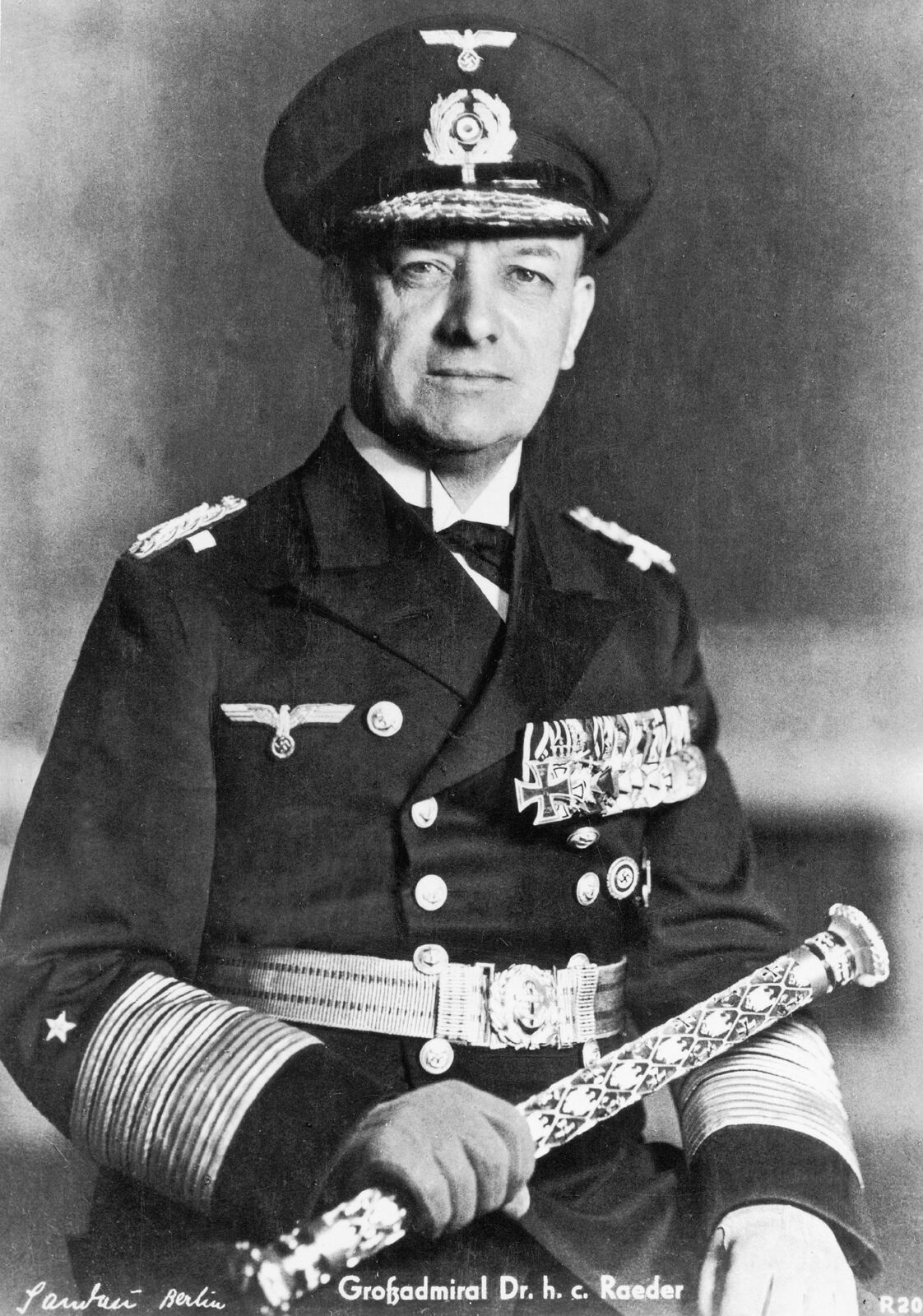
Erich Räder with grossadmiral’s baton
After lunch Hitler was ferried to another ship, the Robert Ley, a large liner that took party loyalists on holiday cruises. He stayed on board throughout Sunday, while the ship tacked back and forth in the waters off Wilhelmshaven, escorted by Scharnhorst and a pair of destroyers. To amuse the Führer, Räder at one point ordered the battle cruiser to steer directly at the liner, only swerving away at the last minute.5
These carefree activities seemed calculated to demonstrate Hitler’s lack of concern at the new international developments. Whether he understood their full import for the navy he was reviewing was open to question. Naval matters played a subordinate role in Hitler’s military calculations, an attitude he did not bother to disguise. He was a soldier not a sailor. Throughout the time at Wilhelmshaven he had worn a brown greatcoat and tunic, the colour of the Flanders mud he had fought in bravely which stood out against the navy blue and gold braid of the attendant admirals. He came from landlocked Austria and was often seasick on his occasional voyages aboard the state yacht Grille.
Grossadmiral Räder, though, was disturbed by the turn that events had taken. He had been born sixty-three years before in Hamburg, the son of a devoutly Christian teacher, and entered the Naval College at Kiel at eighteen. It was the Dreadnought era when great battleships, bristling with guns and laden with armour plating, were the peak of naval power and prestige. He fought the British at Dogger Bank and Jutland and stayed on in the navy, serving the Weimar Republic loyally. In 1928 he was appointed Commander-in-Chief of the Kriegsmarine.
Räder kept his distance from Hitler until he came to power. His first impression of him was favourable. Hitler seemed to him ‘an outstanding personality with a real claim to leadership’.6 He had gained the Führer’s confidence and, once the strategic decisions had been taken, been given a free hand and a generous budget to build up the navy. Hitler had been presented with two choices for his navy. The first proposed a cheap, light, flexible force, centred on submarines and the small but powerfully armed long-range cruisers that the British had nicknamed ‘pocket battleships’. This plan had no pretensions to challenging Britain as a naval power but carried great potential to harm her. The second was to build a big fleet of modern surface ships that would establish Germany as a world maritime force. He had chosen the grandiose option, with Räder’s approval. The result was ‘Plan-Z’, which had been finally agreed by Hitler only two months before. It envisaged a fleet with ten battleships at its core and four aircraft carriers to provide the air power that was becoming a vital adjunct of naval operations. Supporting them would be fifteen pocket battleships, over a hundred cruisers and destroyers and an underwater strength of more than 250 U-boats.
A force of this size would take up to ten years to build. The plan had been designed on the assumption, reinforced by frequent assurances from Hitler, that a war with Britain was still well over the horizon. Only four years before, the two countries had signed the Anglo-German Naval Agreement, mentioned by Hitler in his speech. Germany agreed to limit its surface shipbuilding programme to 35 per cent of the British fleet. In submarines, it was permitted 45 per cent of the Royal Navy’s tonnage, with a clause allowing it to rise to parity in special circumstances. The deal was negotiated in a friendly atmosphere. Historically, both sides had felt respect for one another. When the commander of the British Fleet at Jutland, Lord Jellicoe, died in November 1935, Räder ordered all German warships to fly their flags at half-mast.
A confrontation with the Royal Navy had seemed a distant prospect when Plan Z was being worked out. Now, with Chamberlain’s guarantee to the Poles, it loomed suddenly and alarmingly into view. Räder’s exalted title scarcely reflected the might of his fleet. As he waved his landlubber leader off at the end of his Wilhelmshaven jaunt, he knew very well that he had limited assets with which to face the coming crisis.
The German fleet that spring had only two big ships in service – the battle cruisers Scharnhorst and Gneisenau, both displacing 32,000 tons.* There was a heavy cruiser, the 14,000-ton Admiral Hipper, which would be joined in the coming year by two ships of the same class, the Blücher and the Prinz Eugen. Three pocket battleships were in commission, the Deutschland, Admiral Graf Spee and Admiral Scheer. Despite displacing only 12,000 tons, they packed heavy firepower in their six 11-inch guns. Of the four planned aircraft carriers only one, the Graf Zeppelin, had been laid down, but years of work remained. As for submarines, about fifty would be ready for operations by the end of the summer.
In numerical terms, this was a tiny force when compared with the Royal Navy. It could muster twelve battleships with five more on the way, four battle cruisers, six aircraft carriers with another six building, and twenty-four heavy cruisers. It was only below the waves that numbers were equal.
But strength was not measured in numbers alone. The qualitative difference between the two fleets went a long way towards correcting the quantitative imbalance. The core of the German fleet was modern, whereas many of the British ships dated back to the previous war and only some of them had been updated. The new ships in the pipeline were inferior to their German counterparts. Britain, it would often be lamented in the years to come, had played the game when it came to honouring the various limitations agreements it had entered into in the inter-war years. The Germans had, systematically and ruthlessly, cheated.
All their large ships were bigger than they were supposed to be. The Scharnhorst and Gneisenau were actually 6,000 tons heavier than officially claimed. The extra weight came from the thick armour plating which reduced the danger from the heavier guns of the British battle cruisers. They were also faster than claimed and could muster thirty-one knots, which gave them the edge over their counterparts if forced to run.
It was in the top class – the battleships – that German superiority was most marked. Since Tirpitz and her sister ship Bismarck were laid down in 1936, the Germany Embassy in London, on Räder’s instructions, had lied to the Foreign Office about their specifications. Instead of being 35,000 tons, the upper limit agreed in the Anglo-German Naval Agreement, they would both weigh in at 42,500 tons. The British stuck to the rules. As a result the battleships under construction of the King George V (KGV) class were nearly 12 per cent lighter.
It was not merely a question of size. When finished, Tirpitz and Bismarck would best the Royal Navy’s new ships in every department. They each mounted eight 15-inch guns against the 14-inch main armament of the King George V. They were faster and could travel far greater distances without refuelling. They were also immensely well protected, with thick layers of steel armour encasing decks and hull, turrets, engine rooms and magazines. It was often said by their enemies that the Germans had declared their battleships ‘unsinkable’. The claim does not seem to have been made officially. Their constructors revealed after the war that the Kriegsmarine often intervened during the building of Tirpitz and Bismarck to ‘raise their levels of unsinkability’.7 The result was that, in the case of Tirpitz, 40 per cent of her overall weight was made up of armour plating. The belief grew that Tirpitz and Bismarck could survive any torpedo, shell or bomb that British ships or aircraft could hurl at them, and it was not unfounded. The British navy had been starved of funds in the post-war years, and little effort had been put into developing new weaponry. Torpedoes and shells carried feeble charges and lacked penetrative power. The greatest failure to keep pace with technological developments lay in the area of naval aviation. The Admiralty was only now regaining control of the Fleet Air Arm from the RAF, whose equipment programmes had given priority to fighters and bombers. The navy was entering the war equipped with biplanes that looked like survivors from the previous conflict.
Even with his long-term plan in tatters and Tirpitz and Bismarck still far from completion, Räder could still cause Britain great harm. The Royal Navy suffered from a crucial strategic disadvantage. Britain depended for survival on its seaborne trade. The navy had the duty of protecting a web of routes that stretched to all corners of the globe. Germany, as a continental power, was far less reliant on overseas supplies. If it came to war, its navy’s responsibility was clearer and narrower. Its function was not to protect but to attack, ravaging the sea lanes that linked Britain to the rest of the world.
As the countdown to hostilities accelerated, it was powerful German warships rather than the U-boat fleet that the Admiralty most feared. ‘Nothing would paralyse our supply system and seaborne trade so successfully,’ wrote the First Sea Lord Sir Dudley Pound, just before the outbreak, ‘as attack by surface raiders.’ It was to their detection, pursuit and destruction that the Home Fleet turned as the long overture finished and the curtain went up on the war.
* Von Hassell was a conservative patriot who had been wounded in the First World War and still carried a French bullet in his heart. He was executed for his part in the 20 July 1944 plot to assassinate Hitler.
* All displacements are given as standard, minus the weight of fuel, water and stores that would be carried on voyage.
Конец ознакомительного фрагмента.
Текст предоставлен ООО «ЛитРес».
Прочитайте эту книгу целиком, купив полную легальную версию на ЛитРес.
Безопасно оплатить книгу можно банковской картой Visa, MasterCard, Maestro, со счета мобильного телефона, с платежного терминала, в салоне МТС или Связной, через PayPal, WebMoney, Яндекс.Деньги, QIWI Кошелек, бонусными картами или другим удобным Вам способом.




